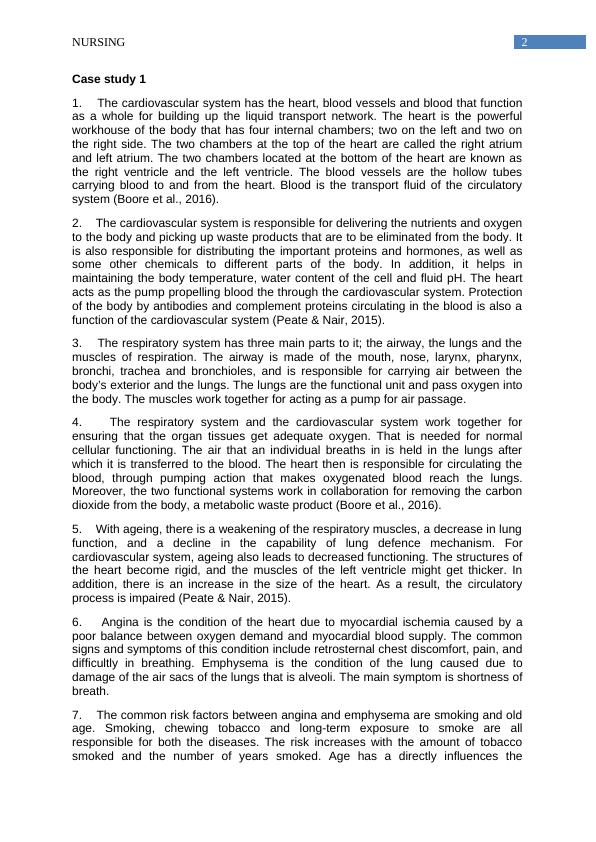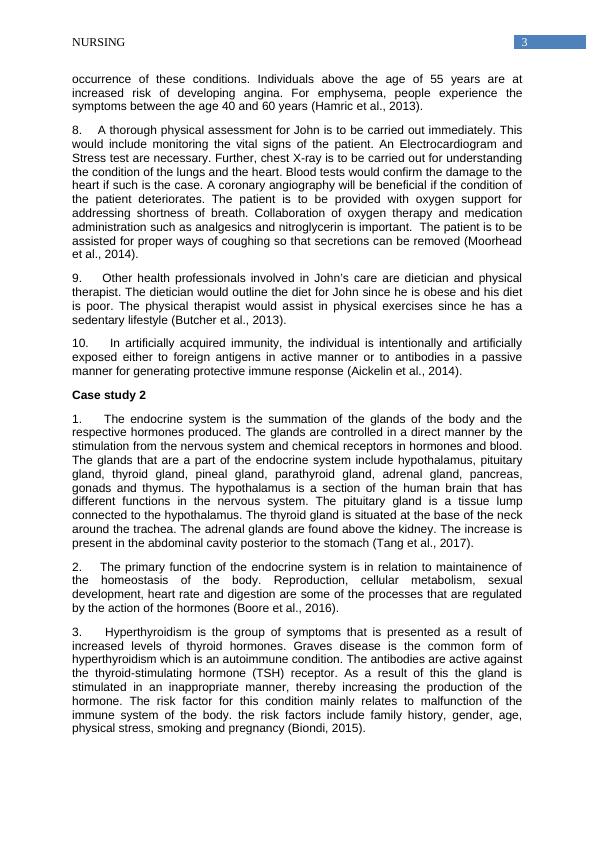Ask a question from expert
HLTAAP002 - Confirm physical health status
8 Pages3457 Words125 Views
Confirm physical health status (HLTAAP002)
Added on 2020-04-21
HLTAAP002 - Confirm physical health status
Confirm physical health status (HLTAAP002)
Added on 2020-04-21
BookmarkShareRelated Documents
1Running head: NURSING NursingName of student:Name of university:Author note:

2NURSING Case study 11. The cardiovascular system has the heart, blood vessels and blood that functionas a whole for building up the liquid transport network. The heart is the powerfulworkhouse of the body that has four internal chambers; two on the left and two onthe right side. The two chambers at the top of the heart are called the right atriumand left atrium. The two chambers located at the bottom of the heart are known asthe right ventricle and the left ventricle. The blood vessels are the hollow tubescarrying blood to and from the heart. Blood is the transport fluid of the circulatorysystem (Boore et al., 2016). 2. The cardiovascular system is responsible for delivering the nutrients and oxygento the body and picking up waste products that are to be eliminated from the body. Itis also responsible for distributing the important proteins and hormones, as well assome other chemicals to different parts of the body. In addition, it helps inmaintaining the body temperature, water content of the cell and fluid pH. The heartacts as the pump propelling blood the through the cardiovascular system. Protectionof the body by antibodies and complement proteins circulating in the blood is also afunction of the cardiovascular system (Peate & Nair, 2015). 3. The respiratory system has three main parts to it; the airway, the lungs and themuscles of respiration. The airway is made of the mouth, nose, larynx, pharynx,bronchi, trachea and bronchioles, and is responsible for carrying air between thebody’s exterior and the lungs. The lungs are the functional unit and pass oxygen intothe body. The muscles work together for acting as a pump for air passage. 4. The respiratory system and the cardiovascular system work together forensuring that the organ tissues get adequate oxygen. That is needed for normalcellular functioning. The air that an individual breaths in is held in the lungs afterwhich it is transferred to the blood. The heart then is responsible for circulating theblood, through pumping action that makes oxygenated blood reach the lungs.Moreover, the two functional systems work in collaboration for removing the carbondioxide from the body, a metabolic waste product (Boore et al., 2016). 5. With ageing, there is a weakening of the respiratory muscles, a decrease in lungfunction, and a decline in the capability of lung defence mechanism. Forcardiovascular system, ageing also leads to decreased functioning. The structures ofthe heart become rigid, and the muscles of the left ventricle might get thicker. Inaddition, there is an increase in the size of the heart. As a result, the circulatoryprocess is impaired (Peate & Nair, 2015). 6. Angina is the condition of the heart due to myocardial ischemia caused by apoor balance between oxygen demand and myocardial blood supply. The commonsigns and symptoms of this condition include retrosternal chest discomfort, pain, anddifficultly in breathing. Emphysema is the condition of the lung caused due todamage of the air sacs of the lungs that is alveoli. The main symptom is shortness ofbreath. 7. The common risk factors between angina and emphysema are smoking and oldage. Smoking, chewing tobacco and long-term exposure to smoke are allresponsible for both the diseases. The risk increases with the amount of tobaccosmoked and the number of years smoked. Age has a directly influences the

3NURSING occurrence of these conditions. Individuals above the age of 55 years are atincreased risk of developing angina. For emphysema, people experience thesymptoms between the age 40 and 60 years (Hamric et al., 2013). 8. A thorough physical assessment for John is to be carried out immediately. Thiswould include monitoring the vital signs of the patient. An Electrocardiogram andStress test are necessary. Further, chest X-ray is to be carried out for understandingthe condition of the lungs and the heart. Blood tests would confirm the damage to theheart if such is the case. A coronary angiography will be beneficial if the condition ofthe patient deteriorates. The patient is to be provided with oxygen support foraddressing shortness of breath. Collaboration of oxygen therapy and medicationadministration such as analgesics and nitroglycerin is important. The patient is to beassisted for proper ways of coughing so that secretions can be removed (Moorheadet al., 2014). 9. Other health professionals involved in John’s care are dietician and physicaltherapist. The dietician would outline the diet for John since he is obese and his dietis poor. The physical therapist would assist in physical exercises since he has asedentary lifestyle (Butcher et al., 2013). 10. In artificially acquired immunity, the individual is intentionally and artificiallyexposed either to foreign antigens in active manner or to antibodies in a passivemanner for generating protective immune response (Aickelin et al., 2014). Case study 21. The endocrine system is the summation of the glands of the body and therespective hormones produced. The glands are controlled in a direct manner by thestimulation from the nervous system and chemical receptors in hormones and blood.The glands that are a part of the endocrine system include hypothalamus, pituitarygland, thyroid gland, pineal gland, parathyroid gland, adrenal gland, pancreas,gonads and thymus. The hypothalamus is a section of the human brain that hasdifferent functions in the nervous system. The pituitary gland is a tissue lumpconnected to the hypothalamus. The thyroid gland is situated at the base of the neckaround the trachea. The adrenal glands are found above the kidney. The increase ispresent in the abdominal cavity posterior to the stomach (Tang et al., 2017). 2. The primary function of the endocrine system is in relation to maintainence ofthe homeostasis of the body. Reproduction, cellular metabolism, sexualdevelopment, heart rate and digestion are some of the processes that are regulatedby the action of the hormones (Boore et al., 2016). 3. Hyperthyroidism is the group of symptoms that is presented as a result ofincreased levels of thyroid hormones. Graves disease is the common form ofhyperthyroidism which is an autoimmune condition. The antibodies are active againstthe thyroid-stimulating hormone (TSH) receptor. As a result of this the gland isstimulated in an inappropriate manner, thereby increasing the production of thehormone. The risk factor for this condition mainly relates to malfunction of theimmune system of the body. the risk factors include family history, gender, age,physical stress, smoking and pregnancy (Biondi, 2015).

End of preview
Want to access all the pages? Upload your documents or become a member.
Related Documents
Transport and Respiration in Biologylg...
|27
|5047
|98
Case Study: 1 2 5 Case Study: 3 11 References 15 Case Study: 1 1. Cardiovascular System of the Bodylg...
|17
|3611
|314
Anatomy and Function of the Cardiorespiratory Systemlg...
|7
|1196
|183
Cardiovascular System | Essaylg...
|8
|2005
|23
Cardiovascular System Assignment 2022lg...
|5
|497
|8
Anatomy and Physiology Essay 3&4 on Human Vascular System and Facial Arterylg...
|4
|1339
|440